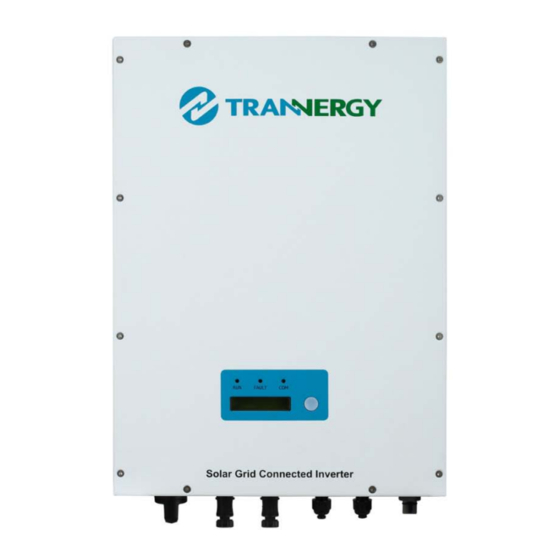Table of Contents
Advertisement
Advertisement
Table of Contents

Summarization of Contents
1. Introduction
1.1. Introduction
Manual describes Trannergy solar inverters and their features.
1.2. How to Use this manual
Guidance on reading the manual and assumed reader knowledge.
1.3. Applied Designations (Warning, Caution, Note)
Explains symbols for safety warnings, property protection, and additional information.
1.4. Important Safety Information
Before installation
Instructions for checking inverter and packaging before installation.
Installation
Procedures for installation by trained personnel.
Disconnecting the inverter
Steps for safely disconnecting the inverter.
operating the inverter
Pre-operation checks for the inverter.
Maintenance and modification
Guidelines for authorized personnel and spare parts.
Functional safety parameters
Consequences of unauthorized changes to safety parameters.
1.5. General Safety Rules for Working on Electrical Equipment
Disconnecting
Rule to disconnect all cables before starting work.
Protecting against reconnection
Preventing accidental reconnection during work.
Checking that system is voltage free
Verifying the system is voltage-free using a tester.
Covering adjacent voltage-carrying components and preventing persons from gaining access to them
Covering and marking live components.
2. Technical Description of Inverters
2.1. Mechanical design
Shows outline dimensions of different inverter models.
3. Operation Mode Definition
3.1. Waiting mode
Describes the inverter's waiting mode and voltage conditions.
3.2. Connecting mode
Details the transition to connecting mode after system tests.
3.3. Normal mode
Explains normal operation, power feedback, and grid connection.
3.4. Fault mode
Explains the fault mode and troubleshooting recommendations.
4. Installation and startup
4.1. Installation precaution
Safety precautions for installation, including danger and caution notes.
4.2. Installing the inverter
Procedure for installing the inverter, including drilling and mounting board.
4.3. Electrical connection
Shows connection terminals for Product A and Product B.
4.3.1 Connection to the grid (AC) for Product A
Instructions for connecting AC wires for Product A.
4.3.2 Connection to the grid (AC) for Product B
Instructions for connecting AC cable for Product B.
4.3.3 Connection to the PV generator (DC) for Product A&B
Information and table for DC connection to PV generator.
4.4. Run the inverter
Steps to start the inverter after installation and checks.
5. Human Machine Interface
5.1. Control Panel
Explains the LEDs (RUN, FAULT, COM) and the Function key.
5.2. LCD Functions
Describes various parameters displayed on the LCD.
5.3. Language Settings
Instructions on how to set the language.
5.4. Auto Test Settings
Instructions for performing the auto test function for Italian Standard.
5.5. Power Factor Settings
How to adjust PF according to VDE-AR-N 4105 standard.
5.6. Power Limit Settings
How to adjust Power Limit according to VDE-AR-N 4105 standard.
6. Communication and Monitoring
6.1. Communication Interfaces
Describes communication interfaces like RS-232, RS-485, and Wireless.
6.2. Communication
Overview of communication types for managing the power station.
6.2.1. RS-232 Communication for single inverter type
Details RS-232 communication between PC and a single inverter.
6.2.2. RS-485 Communication for Several inverters
Explains RS-485 communication for multiple inverters up to 32 units.
6.2.3. Wireless
Mentions wireless communication capability for inverters with customization options.
6.3. Monitoring
Describes system monitoring using PVCS software and RS-485 interface.
7. Service and repair
7.1. Safety during service and repair
Safety precautions and notes for servicing and repairing the inverter.
7.2. Troubleshooting
Guide to troubleshoot common PV system problems before calling for assistance.
8. Technique specification
8.1. Electrical Specification
Details electrical specifications including input and output parameters.
8.1.1. Input Specification
Lists input voltage, current, and MPP tracker specifications for different models.
8.1.2. Output Specification
Lists nominal/maximum output power, voltage, current, and frequency.
8.1.3. General Data
Provides general data like power consumption, efficiency, and protection degree.










Need help?
Do you have a question about the PVI1800TL and is the answer not in the manual?
Questions and answers